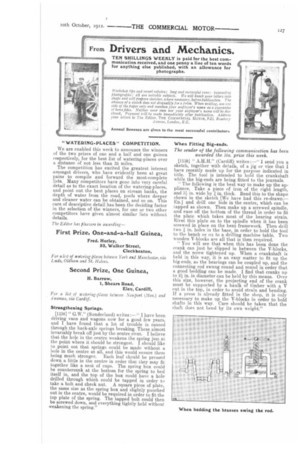From Drivers and Mechanics.
Page 25

If you've noticed an error in this article please click here to report it so we can fix it.
TEN SHILLINGS WEEKLY is paid for the best corn~do, munication received, and one penny a line of ten words rWM:r for anything else published, with an allowance for 1 r
photographs.
—4611aiiiiiainwomorineare:agamumalair Workshofi lips and smart rePairs; long and successful runs; interesting photographs ; all are suitable subjects. We will knock your letters into shape and will prepare sketches, where necessary, before Publication. The absence of a sketch does not disqualify for a prize. When uniting, use one side of the paper only and mention your employer's name as a guarantee of bona fides. Neither your ottm nor your employer's name will be disclosed. Payment will be made immediately after Publication. Address your tellers to The Editor, THE COMMERCIAL MOTOR, ?-15, Eosebery
Avenue, London, E.G.
_13 Annual Bonuses are given to the most successtul contributors.
"WATERING-PLACES" COMPETITION.
We are enabled this week to announce the winners of the two prizes of one and a half and one guinea respectively, for the best list of watering-places over a distance of not less than 35 miles.
The competition has excited the greatest interest amongst drivers, who have evidently been at great pains to compile and forward the most-complete lists. Many competitors have gone into very careful detail as to the exact location of the watering-places, and point out the best places on stream banks, the depth of water from the road, pools where deeper and cleaner water can be obtained, and so on. This care of descriptive detail has been the deciding factor in the selection of the winners, for one or two other competitors have given almost. similar lists without details.
The Editor has tleasure in awarding—
[1138] " G.W." (Sunderland) writes :—" I have been driving vans and wagons now for a good few years, and I have found that a lot of trouble is caused through the back-axle springs breaking. These almost invariably break off just by the centre rivet. I believe that the hole in the centre weakens the spring just at the point where it should be strongest. I should like to point out that springs could be made without a hole in the centre at all, and this would ensure them being much stronger. Each leaf should be pressed down a little in the centre in order that they may fit together like a nest of cups. The spring box could be countersunk at the bottom for the spring to bed itself in, and the top of the box could have a hole drilled through which could be tapped in order to take a bolt and check nut. A square piece of plate, the same size as the spring box and slightly punched out in the centre, would be required in order to fit the top plate of the spring. The tapped bolt could then be screwed down, and everything tightly held without weakening the spring." When Fitting Big-ends.
The sender of the following communication has been awarded the 108. prize this week.
[1139] " A.H.H." (Cardiff) writes :—" I send you a sketch, together with details, of a jig or vice that I have recently made up for the purpose indicated in title. The tool is intended to hold the crankshaft while the big-ends are being fitted to the journals.
" The following is the best way to make up the appliance. Take a piece of iron of the right length, and 31. in. wide by a in. thick. Bend this to the shape shown in the sketch [We have had this re-drawn,En.] and drill one hole in the centre, which can be Lapped as shown. Then make up a screwed spindle, and ease off the bottom of the thread in order to fit the plate which takes most of the bearing strain. Rivet this plate on to the spindle when it has been screwed in place on the bent framework. Then drill two in. holes in the base; in order to hold the tool to the bench or on to a drilling machine table. Two wooden V-blocks are all that is then required.
"You will see that when this has been done the crank can just be slipped in between the IT-blocks, and the screw tightened up. When a crankshaft is held in this way, it is an easy matter to fit up the big-ends, as the bearings can be coupled up, and the connecting rod swung round and round in order that a good bedding can be made. I find that cranks up to 21. in. in diameter can be held by this means. Over this size, however, the projecting end of the crank must be supported by a baulk of timber with a V cut in the top, in order to avoid strain and bending. If a press is already fitted in the shop, it is only necessary to make up the V-blocks in order to hold shafts in this way. Clare should be taken that. the shaft does not bend by its own weight."


























